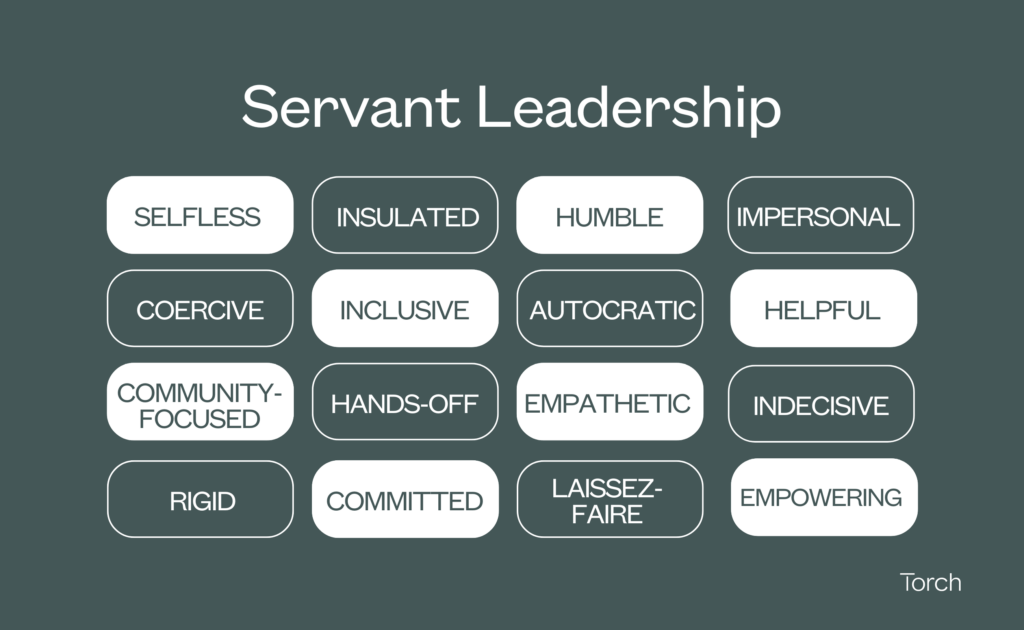In recent years, leaders have transitioned from focusing on how their followers can serve their needs to now focusing on how they can better serve the needs of their followers. No leadership style exemplifies this more than servant leadership.
In this post, we’ll explore the definition of this leadership style, its pros and cons, as well as what this type of leader looks like in action.
What is Servant Leadership?
As a servant leader, you put the needs, growth, and wellbeing of your followers first. This means adopting a serve-first mindset and prioritize your organization, employees, and community above themselves.
Servant leadership is in direct contrast to styles like autocratic leadership, transactional leadership, and bureaucratic leadership – all of which focus on structure, hierarchy, and a rigid give-take relationship. Alternatively, it shares similarities with transformational leadership and democratic leadership.
Characteristics of Servant Leadership
To best understand the characteristics of servant leadership, it may be helpful to turn to “The Servant As Leader,” which is an essay written by the founder of this leadership style: Robert K. Greenleaf.
Based on his essay, we can identify key traits of a servant leader:
- – Committed to serving the needs of others
- – Selfless and humble
- – No interest in holding onto power or material possessions
- – Community focused
- – Highly empathetic

The 10 Principles of Servant Leadership
What does servant leadership look like in practice?
After years of reflecting on Greenleaf’s original writings, Larry C. Spears, former president of the Robert K. Greenleaf Center for Servant Leadership, identified 10 key principles of servant leadership. They include:
1. Listening
Servant leaders listen intently to others. They take note of what is being said and unsaid. They also take time to listen, process, and reflect.
2. Empathy
Servant leaders operate with empathy. They recognize and understand the needs of their team, enabling them to build trust and actually boost job performance.
3. Healing
Imagine this: you have a new direct report who previously worked at another company under a toxic manager. You sense that they feel demotivated or unconfident in their work.
Servant leaders recognize that they have an opportunity to “heal” those around them. This might sound like a lofty or difficult undertaking, but it can be as straightforward as fostering a healthy working environment, creating work-life balance, and making each member feel respected and valued.
Ready to transform how leaders grow?
4. Awareness
Servant leaders are aware of issues happening around them and their team, as well as future threats and opportunities. They’re also self-aware, enabling them to take inventory of their own strengths, weaknesses, emotions, and biases.
5. Persuasion
Servant leaders rely on persuasion — not their authority — to make decisions and to get things done. They seek to convince their team, rather than force them into complying. As a result, everyone feels like they have a say in decisions.
6. Conceptualization
While achieving short-term goals is important to servant leaders, they also leverage big-picture thinking to create a vision beyond day-to-day realities.
7. Foresight
Servant leaders can’t predict the future, but they reflect on the lessons of the past and apply them to future planning, enabling them to make informed decisions. They also listen to their team members, who may have foresight of their own.
8. Stewardship
Servant leaders do their best to be of service to others. They lead by example, fostering a culture of trust, accountability, and ethical behavior.
9. Commitment to the growth of people
Servant leaders are deeply committed to the growth of their people. They invest in their team members’ personal and professional development, providing opportunities for learning and advancement — such as leadership coaching.
10. Building community
Building community is a core principle of servant leadership. Servant leaders foster a sense of belonging and connection among team members and encourage open communication and mutual respect.
What Are The Pros and Cons of Servant Leadership?
Servant leadership comes with many benefits. But, just like any other leadership style, it can have some downsides as well. It’s important to be familiar with both the pros and cons so you have a full understanding of this leadership style before implementing it in your own role. We outline the most significant considerations below.
Pros
- – Focuses on the development and growth of others
- – Can lead to improved performance, innovation, and collaboration
- – Creates a safe environment where people aren’t afraid to fail
- – Reduces turnover and disengagement
- – Increases trust with leaders
Cons
- – Servant leaders can become more easily burnt out
- – Resource intensive
- – Difficult to train other leaders in the serve-first mindset
- – Can take longer to see results or reach goals
- – Has the potential to be perceived as ‘weak’
True behavior change can create a positive ripple effect throughout your organization.
Learn how to cultivate “moments that matter” in our latest guide.
What Type Of Person Is A Servant Leader?
Let’s imagine you work at a company where the CEO, Taylor, practices a servant leadership style. It’s evident that she cares deeply about her people – from the executives she works with everyday to the new hires she hasn’t met yet. Taylor demonstrates her caring through her actions.
Instead of sitting in her office with the door closed, Taylor makes a point of eating lunch with her employees, checking in on them through Slack, and always expressing gratitude for their hard work.
Any time an employee comes to her with a problem, needs, or question – which is frequently – she always makes herself available. Not only that, but she’ll prioritize getting them the support they need – whether that’s in the form of learning and development opportunities, additional company benefits, or any other resources her team needs.
Taylor isn’t only focused on serving her own employees. She’s also passionate about giving back to the local community. That’s why she’s an advocate of corporate social responsibility, volunteers her time to causes she cares about, and focuses on providing products and services that truly help people over those that might create more revenue.
While Taylor is prone to overworking herself and using company resources in a way that doesn’t immediately boost the bottom line, she feels it’s completely worth it. Her employees are happy and fulfilled, and her organization is a beloved presence in their community for all the positive contributions it makes.
Servant leadership takes a lot of time, dedication, and resources to implement. But the results speak for themselves. If this is a leadership style that resonates with you, we encourage you to take the first steps to put it into practice in your own role.









